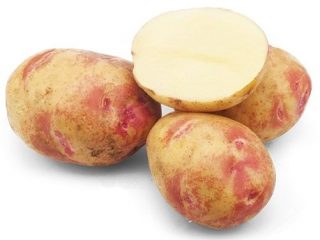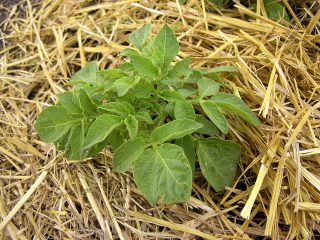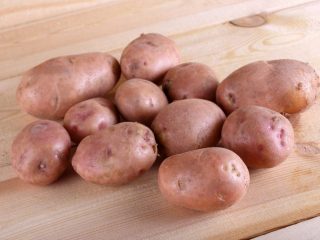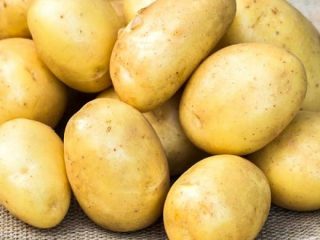Content
To the question of how to plant potatoes correctly: sprouts up/down, it is impossible to give a definite answer. Both methods are not without significant advantages and significant disadvantages; accordingly, the decision always remains with the gardener. But in any case, you cannot count on a good harvest if you plant potatoes without preliminary preparation and do not study the important nuances of the method of planting with sprouts up or down.
Where are the potato sprouts?
The “rudiments” of potato stems appear from “eyes” - rounded “spots” that are darker than the main shade of the skin. They can be located flush with the surface of the peel or be slightly “recessed” into the pulp.

“Eyes” often feel rough to the touch
How to plant potatoes with sprouts up or down
It is impossible to say unequivocally that it is correct to plant potatoes with their sprouts up or down. But the first method is considered basic because of its versatility. Its “applicability” does not depend on the planting scheme and the quality of the substrate in the garden bed.
When to plant potatoes sprouts up
Planting tubers, immediately directing future stems upward is the only option for clay and other “heavy” soils.There is also no alternative for gardeners who want to “compact” the plants in the garden and have planting material with excessively long (more than 1.5-2 cm) sprouts.
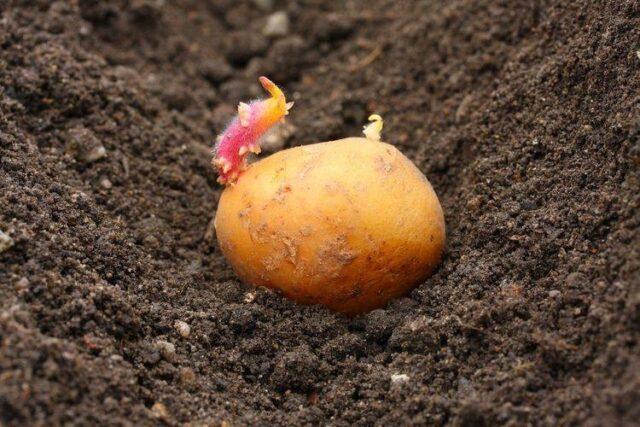
Planting potatoes so that the stems initially stretch upward is a classic method.
When planning to plant “in the upward direction”, you need to take into account that the tubers sprout quite quickly. Accordingly, there is a risk of young plants being exposed to return spring frosts. Another important nuance is that the volume and quality of the future harvest depend not only on how lucky the gardener is with the weather in the summer, but also on how well the garden beds are cared for. This is especially true for watering and fertilizing.
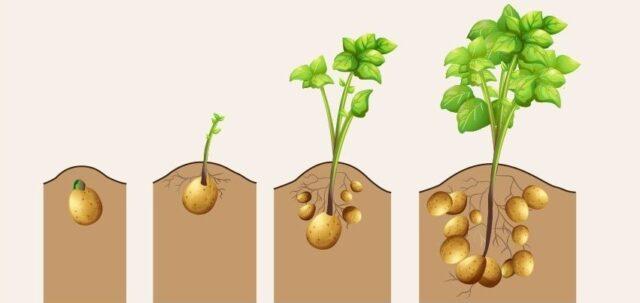
The most powerful shoots are formed from the apical “eye”
Gardeners who prefer to plant potatoes with their sprouts facing up highlight the following advantages of this method:
- Stems from sprouts initially directed upwards develop without additional “obstacles.” Accordingly, such potatoes sprout earlier.
- With early planting, the risk of potato seedlings dying from cold is less. Future stems are initially “stretched” towards warmth.
- If the holes must be deep (from 10 cm), when planted with the sprouts facing up, the potatoes demonstrate much better germination.
- Tubers can be selected less pickily. If you place them the other way around, the stems will need more nutrients to break through to the surface. Only large planting tubers can provide them.
- If planted with sprouts facing up, the young seedlings have time to become sufficiently strong before the period of “activation” of Colorado potato beetles and other pests. Many insects avoid “hard” stems and leaves.
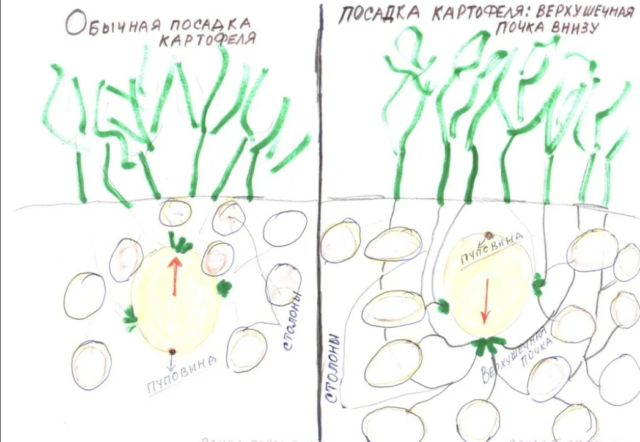
Potato bushes of the same variety, if planted with their “awakened” “eyes” up and down, differ noticeably in size
How to plant potatoes sprouts down
In this way, you cannot plant potatoes with large (from 1-1.5 cm) sprouts. Otherwise, they will simply break under the weight of tubers weighing at least 80 g. The substrate in the garden must be light and loose, but at the same time quite fertile.
The maximum depth of the holes is 10 cm. The planting pattern must be “sparse”. Sprouts directed downwards come to the surface, “bending around” the tuber from different sides, therefore, regardless of the description of the variety or hybrid, the potato bush turns out to be “sprawling”.
Most often, gardeners use the square-nest method, planting tubers in the corners of a “lattice” with square cells with a side of 50-70 cm or in the center of these squares. It is also common to plant potatoes sprouts down in a checkerboard pattern with row spacing 80-90 cm wide, when the interval between tubers in a row is 45-50 cm and each row is “shifted” relative to the previous one by half this distance. A less popular, but also acceptable method is to plant potatoes with sprouts downwards according to J. Mittlider. The row spacing here is very wide (1-1.2 m), the tubers are planted in a checkerboard pattern in two “lines” with an interval of 30-40 cm.
Tubers “on the contrary” are planted in well-loosened soil; they cannot be deeply buried; there is no need to dig individual holes - it is enough to mark a general furrow.The use of fertilizers is recommended - most often humus mixed with wood ash is placed at the bottom. It is not prohibited to use complex store-bought fertilizers and folk remedies to protect against diseases and repel pests. The tubers are laid out, covered with soil, and the surface of the bed is leveled.
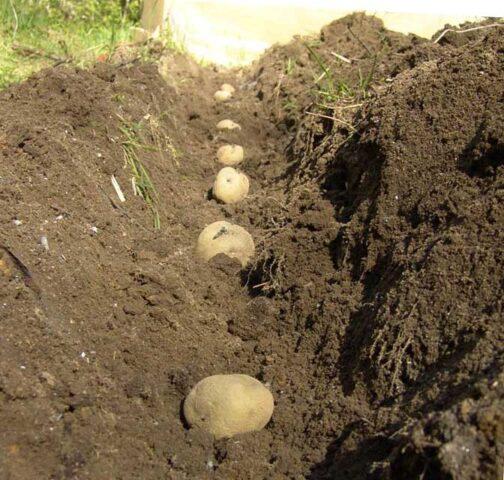
It is forbidden to compact the soil in the garden bed if the tubers are planted with their sprouts facing down.
It takes longer to sprout potatoes. They “break through” not only through the soil, but also through the “web” of roots, sprouts from gradually activated “eyes”. But the bushes turn out to be more powerful and hardy, and the risk of them falling under return frosts is minimized. Their root system is better developed, so you can count on a larger harvest. The stems are not located “clumped”, but rather in a circle.
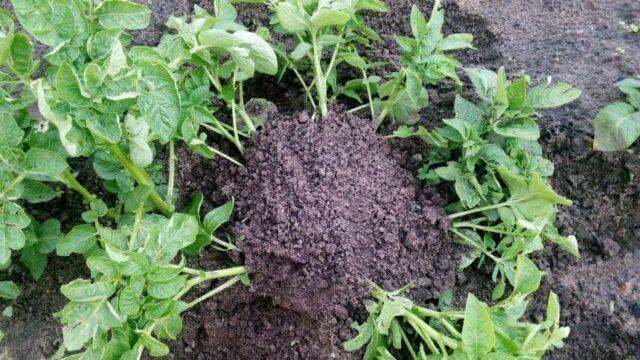
After fan hilling, the stems rise quite quickly, in 3-4 days
Gardeners who plant potatoes sprouts down for several seasons claim that yields increase significantly with this method. At the same time, the bushes require minimal care - mulch prevents moisture from evaporating too quickly and prevents the growth of weeds. And powerful roots successfully “pull” nutrients from the soil, allowing you to do without frequent fertilizing.
How to prepare potatoes for planting
Pre-planting preparation of potatoes includes the following mandatory steps:
- A thorough inspection of planting material, “rejection” of all tubers that have even minor mechanical damage, traces of damage by mold, rot, and other pathogens.
- Germination of tubers at a temperature of 10-15 ° C in a bright room with good ventilation.
- Treatment of potatoes immediately before planting with fungicides, insecticides, biostimulants. Preparations are selected based on the description of the variety or hybrid - it indicates which diseases it is most susceptible to, which pests it is most often attacked by, and there is data on the general endurance of the plants.
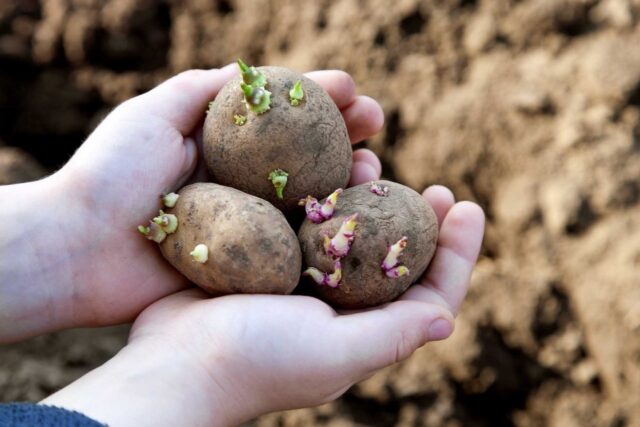
At low air humidity in the room, germinated tubers need to be sprayed with water every 3-4 days
The only difference in preparation is the timing of potato germination. If you plan to plant with sprouts up, the procedure is extended for 3.5-4 weeks. When they are pointed downwards, 7-10 days are enough.
Common Mistakes
Planting potatoes with their sprouts up or down seems like a simple, even primitive procedure. However, here too you can make mistakes that will negatively affect the volume and quality of the harvest:
- Excessive “crowding” in the garden. This is especially dangerous if you plant potatoes with their sprouts facing down. Bushes that do not receive enough heat, light and nutrients will definitely not produce a good harvest.
- Plant several small tubers in one hole, placing them side by side. Regardless of their position with the sprouts up or down, they need to be “removed” from each other in order to avoid the same “crowding”.
- Plant potatoes too early. The substrate must warm up to 9-10 °C, otherwise the shoots, “directed” both upward and downward, may freeze and die without sprouting.
- Excessive depth.If potatoes are placed in holes with their sprouts facing up, they still have a chance to germinate, even if it takes a long time. In the “down” position, there is no need to wait for seedlings.
- Excess nitrogen. This macronutrient stimulates the rapid growth of green mass, but if you overdo it, the potato sprouts become very thin. When they are directed downwards rather than upwards, they almost certainly will not penetrate the soil.
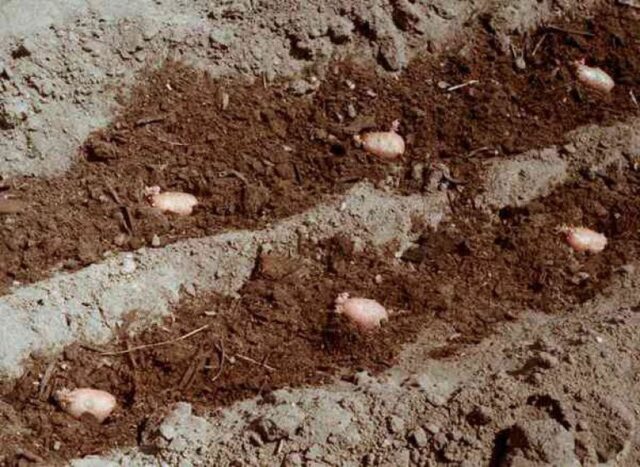
To prevent excessive planting density, it is necessary to take into account the general patterns and characteristics of a particular variety or hybrid
Conclusion
The answer to the question, whether it is correct to plant potatoes with their sprouts up/down, is something every gardener finds for himself, “experimentally.” Most summer residents practice the “classical” method, but the “non-traditional” option also has a right to exist. To understand whether it is suitable for given climatic conditions and type of substrate, it is recommended to “test” it on several small beds, having first studied the nuances of the technique.

